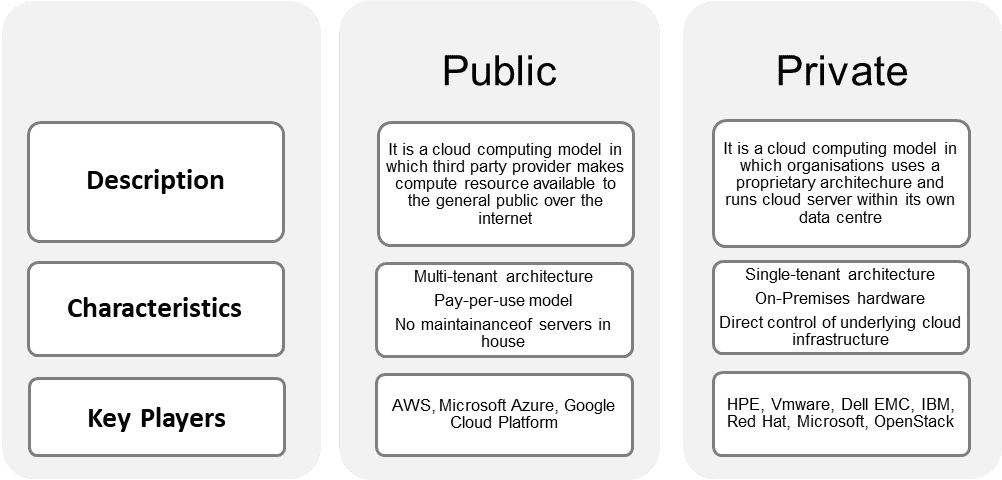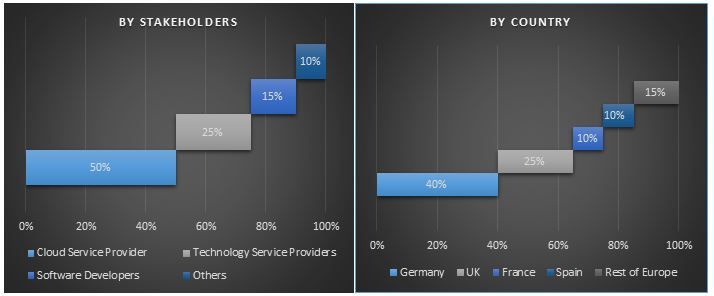- Strona główna
- O nas
- Branża
- Usługi
- Czytanie
- Kontakt
Analiza rynku europejskiego infrastruktury chmury: Wnioski i prognoza, 2018-2024
Nacisk na typ wdrażania (chmura publiczna, chmura prywatna), usługi chmury publicznej (SaaS, PaaS, IaaS, reklama w chmurze, BPaaS), użytkownik końcowy (bankowość, usługi finansowe i ubezpieczeniowe, handel detaliczny, telekomunikacja & IT, opieka zdrowotna, media & rozrywka, agencje rządowe, edukacja, energetyka, produkcja, inne branże)
Europejski rynek infrastruktury chmury znacznie się rozrósł. Niedobór umiejętności w europejskim sektorze IT stworzył ciekawe możliwości outsourcingu. Obecny trend ICT, a mianowicie przetwarzanie w chmurze, stanowi ewolucję, w której chmura w wielu aspektach przyczynia się do przyspieszenia innowacji technologicznych. Zbieżne zmiany w ICT w regionie europejskim w ostatnich latach znacznie zwielokrotniły wybory dostępne zarówno dla użytkowników, jak i dostawców technologii. Technologia chmury stworzyła innowacyjne możliwości zarówno dla dostawców usług, jak i konsumentów usług chmurowych w Europie, ponieważ technologia w Europie charakteryzuje się byciem młodą, innowacyjną i dynamiczną, a także wykazuje niskie bariery wejścia. Technologia chmury oferuje europejskim firmom możliwość stania się liderami na rynku. Umożliwia MŚP budowanie biznesów i wykorzystywanie mocy obliczeniowej po niskich kosztach, co wcześniej wymagało początkowej inwestycji w ICT, która przekraczała ich możliwości.
Graficzne przedstawienie modelu wdrażania przetwarzania w chmurze analizowanego w badaniu
Europejski Rynek Infrastruktury Chmury wygenerował przychody w wysokości US XX miliardów dolarów i przewiduje się, że odnotuje rozsądny wzrost o 10% w okresie prognozowanym (2018-2024). Wskaźnik adopcji technologii chmury w Europie ma wykazywać wielokrotny wzrost w nadchodzących latach, co przypisuje się przede wszystkim szybkiemu dojrzewaniu technologii chmury oraz dynamicznemu i konkurencyjnemu środowisku IT. Technologia chmury stopniowo zredefiniowała sposób, w jaki jest wykorzystywana wśród przedsiębiorstw i użytkowników końcowych, zwłaszcza w krajach rozwiniętych, takich jak Wielka Brytania, Niemcy i Francja, co przewiduje się, że przeniknie do innych krajów, a mianowicie Irlandii, Austrii i Finlandii. Wraz z konsekwentnym dojrzewaniem i standaryzacją przewiduje się, że coraz więcej firm będzie adoptować technologię chmury, przewidując korzyści z innowacji IT. Jednak fragmentacja jednolitego rynku cyfrowego, przejrzystość i ochrona danych oraz zdolność integracji stanowią niektóre z parametrów ograniczających potencjał rynkowy.
Wnioski przedstawione w raporcie:
- Raport analizuje usługi infrastruktury chmury głównie dlamodelu wdrażania publicznego i prywatnegow regionie europejskim. Aby dodatkowo wzbogacić analizę, raport segmentuje również rynek na podstawie usługi infrastruktury chmury, branży użytkownika końcowego, która jest wdrażana w różnych krajach na całym świecie.
- Raport analizuje wszystkiepotencjalne kraje, które wykazały zwiększone wdrożenie usług chmurowychw ciągu ostatniej dekady. Model wdrażania chmury publicznej i prywatnej jest dalej podzielony na różne usługi, w tym chmurę publiczną (oprogramowanie jako usługa (SaaS), platforma jako usługa (PaaS), infrastruktura jako usługa (IaaS), proces biznesowy jako usługa (BPaaS) i reklama w chmurze. Usługi chmury publicznej związane z reklamą w chmurze zdominowały rynek w 2017 roku, z udziałem w rynku wynoszącym 44%.
- Model wdrażania chmury prywatnej jest podzielony na hosting zarządzany i ko-lokację, a pierwszy z nich miał maksymalny udział w rynku chmury w Europie. Szacuje się, że Hosting Zarządzany będzie rósł ze stosunkowo wysokim CAGR wynoszącym 13% w okresie prognozowanym.
- Raport analizuje również różnepotencjalne branże użytkowników końcowych, którzy są najczęstszymi adaptatoramii najprawdopodobniej będą motorem wzrostu dla branży. Bankowość, usługi finansowe i ubezpieczeniowe, handel detaliczny, telekomunikacja & IT, opieka zdrowotna, media & rozrywka, agencje rządowe, edukacja, energetyka i produkcja, między innymi, to główne branże użytkowników końcowych analizowane podczas badania. W sektorze telekomunikacji & IT generowana jest ogromna ilość danych, dlatego sektor ten stał się największym użytkownikiem przetwarzania w chmurze, stanowiąc 17% udziału w rynku w 2017 r..
- Dla lepszego zrozumieniageograficznego penetracji rynku usług chmurowychw regionie europejskim, rynek jest analizowany na podstawie jegozasięgu w krajachtakich jak Niemcy, Francja, Wielka Brytania, Hiszpania, Rosja, Włochy i reszta Europy. Niemcy mają jeden z największych udziałów w globalnym rynku przetwarzania w chmurze, co zawdzięczają rozwijającej się cyfryzacji w każdym aspekcie, podczas gdy Francja zajmuje drugie co do wielkości miejsce na europejskim rynku przetwarzania w chmurze, głównie ze względu na rosnącą akceptację przetwarzania w chmurze przez nowych i wschodzących graczy, w połączeniu z małymi i średnimi przedsiębiorstwami. Ponadto, Wielka Brytania również zyskała na znaczeniu i stanowi znaczące miejsce dla usług chmurowych wśród przedsiębiorstw ze względu na ogromną bazę klientów, zaawansowaną gospodarkę i brak wąskich gardeł infrastrukturalnych. Oczekuje się, że niemiecki rynek infrastruktury chmury osiągnie 22,0 miliardy USD do 2024 roku.
- Europejski rynek przetwarzania w chmurze zapewnia równieżbenchmark konkurencyjny wiodących graczyna tym rynku, który obejmuje profilowanie firm takich jak Cisco System Inc., Equinix Inc., Google Inc., IBM Corporation, Salesforce.com, AT&T Inc., Amazon Web Services Inc., DXC Technology Company, HP Inc. i Rackspace Hosting Inc. Firmy te działają w tym sektorze od kilku lat i mają zdywersyfikowane portfolio produktów, innowacyjne technologie i silne sieci dystrybucji na całym świecie.
Powody, dla których warto kupić raport:
- Badanie obejmuje określanie wielkości rynku i analizę prognozowania zatwierdzoną przez autentycznych kluczowych ekspertów branżowych
- Raport przedstawia szybki przegląd ogólnych wyników branży na pierwszy rzut oka
- Raport zawiera dogłębną analizę wybitnych rówieśników z branży, koncentrując się przede wszystkim na kluczowych wskaźnikach finansowych biznesu, portfolio produktów, strategiach ekspansji i ostatnich wydarzeniach
- Szczegółowe badanie czynników napędowych, ograniczeń, kluczowych trendów i możliwości występujących w branży.
- Analiza atrakcyjności branży za pomocą analizy Pięciu Sił Portera
- Badanie kompleksowo obejmuje rynek w różnych segmentach
- Dogłębna analiza regionalna branży
Opcje dostosowywania:
Europejski rynek infrastruktury chmury może być dostosowany do poziomu krajowego lub dowolnego innego segmentu rynku. Poza tym, UMI rozumie, że możesz mieć własne potrzeby biznesowe, dlatego oferujemy również w pełni dostosowane rozwiązania dla klientów.
Spis treści
Analiza historycznego rynku, oszacowanie obecnego rynku i prognozowanie przyszłego rynku dla europejskiego rynku usług infrastruktury chmury były trzema głównymi krokami zaangażowanymi w tworzenie i analizę ogólnego rynku europejskiego rynku usług infrastruktury chmury. Przeprowadzono wyczerpujące badania wtórne w celu zebrania historycznego rynku technologii i ogólnego oszacowania obecnego rynku. Po drugie, aby zweryfikować te spostrzeżenia, wzięto pod uwagę liczne ustalenia i założenia. Ponadto przeprowadzono wyczerpujące wywiady pierwotne z ekspertami branżowymi w całym łańcuchu wartości europejskiego rynku usług infrastruktury chmury. Po wszystkich założeniach, ustaleniu wielkości rynku i walidacji danych rynkowych za pośrednictwem wywiadów pierwotnych, zastosowano podejście z góry na dół, aby prognozować całkowity rozmiar rynku europejskiego rynku usług infrastruktury chmury. Następnie zastosowano metody podziału rynku i triangulacji danych, aby oszacować i przeanalizować wielkość rynku segmentów i podsegmentów technologii. Szczegółowa metodologia jest wyjaśniona poniżej:
Analiza historycznej wielkości rynku
Krok 1: Szczegółowe badanie źródeł wtórnych:
Przeprowadzono szczegółowe badania wtórne w celu uzyskania historycznej wielkości rynku europejskiego rynku usług infrastruktury chmury za pośrednictwem wewnętrznych źródeł firmy, takich jakraporty roczne i sprawozdania finansowe, prezentacje wyników, komunikaty prasowe, ewidencja zapasów, dane dotyczące sprzedaży itp.oraz źródła zewnętrzne, w tymczasopisma artykuły prasowe, publikacje rządowe, publikacje konkurencji, raporty sektorowe, publikacje organów regulacyjnych, organizacje ds. norm bezpieczeństwa, bazy danych stron trzecich i inne wiarygodne publikacje.
Krok 2: Segmentacja rynku:
Po uzyskaniu historycznej wielkości rynku dla całego rynku, przeprowadzono szczegółową analizę wtórną w celu zebrania historycznych danych rynkowych i udziału dla różnych segmentów i podsegmentów europejskiego rynku usług infrastruktury chmury. Główne segmenty uwzględnione w raporcie to model wdrażania publicznego i prywatnego, usługa infrastruktury chmury i branża użytkownika końcowego. Dalsza analiza została również przeprowadzona dla podsegmentów głównych segmentów europejskiego rynku usług infrastruktury chmury.
Krok 3: Analiza czynnikowa:
Po uzyskaniu historycznej wielkości rynku różnych segmentów i podsegmentów, szczegółowaanaliza czynnikowazostała przeprowadzona w celu oszacowania obecnej wielkości europejskiego rynku usług infrastruktury chmury. Analiza czynnikowa została przeprowadzona z wykorzystaniem zmiennych zależnych i niezależnych, takich jak preferencje dotyczące typu modelu wdrażania, tj. publicznego i prywatnego, siła nabywcza klientów, obawy dotyczące bezpieczeństwa danych itp. Przeanalizowano historyczne trendy europejskiego rynku usług infrastruktury chmury oraz ich wpływ rok do roku na wielkość i udział w rynku w ostatnim czasie. Scenariusz po stronie popytu i podaży został również dokładnie zbadany.
Szacunkowy Rozmiar i Prognoza Bieżącego Rynku
Określanie Rozmiaru Rynku:W oparciu o praktyczne wnioski z powyższych 3 kroków, ustaliliśmy obecny rozmiar rynku, kluczowych graczy w głównych zastosowaniach i rynkach, udziały rynkowe tych graczy, łańcuch dostaw i łańcuch wartości branży. Wszystkie wymagane udziały procentowe, podziały i podziały rynku zostały określone z wykorzystaniem wspomnianego podejścia wtórnego i zweryfikowane poprzez wywiady pierwotne.
Szacowanie i Prognozowanie:Do szacowania i prognozowania rynku przypisano wagi do różnych czynników, w tym trendów i czynników napędzających, ograniczeń i możliwości. Po przeanalizowaniu tych czynników zastosowano odpowiednie techniki prognozowania, tj. Bottom-up/Top-down, aby uzyskać prognozę rynkową na rok 2024 dla różnych segmentów i podsegmentów technologii w głównych krajach europejskich. Metodologia badawcza przyjęta do oszacowania wielkości rynku obejmuje:
- Wielkość rynku branży pod względem wartości (USD) i wskaźnika adopcji usług Infrastruktury Chmury w głównych krajach europejskich
- Wszystkie udziały procentowe, podziały i podziały segmentów i podsegmentów rynku
- Kluczowi gracze w głównych zastosowaniach i rynkach, a także udział rynkowy każdego gracza. Ponadto strategie wzrostu przyjęte przez tych graczy, aby konkurować na stale rosnącym europejskim rynku usług Infrastruktury Chmury
Walidacja Wielkości i Udziału Rynku
Badania Pierwotne: Przeprowadzono dogłębne wywiady z kluczowymi liderami opinii (KOL), w tym z najwyższymi rangą kierownikami (CXO/VP, szef sprzedaży, szef marketingu, szef operacyjny i szef regionalny itp.). Wyniki badań pierwotnych zostały podsumowane, a analiza statystyczna została przeprowadzona w celu udowodnienia postawionej hipotezy. Dane z badań pierwotnych zostały skonsolidowane z ustaleniami wtórnymi, przekształcając w ten sposób informacje w praktyczne wnioski.
Podział Uczestników Pierwotnych
Inżynieria Rynku
Zastosowano technikę triangulacji danych w celu ukończenia ogólnego procesu inżynierii rynku, aby uzyskać precyzyjne dane statystyczne każdego segmentu i podsegmentu dotyczących europejskiego rynku usług Infrastruktury Chmury. Dane podzielono na kilka segmentów i podsegmentów po przestudiowaniu różnych parametrów i trendów w obszarach Typu Wdrożenia, tj. Wdrożenie Publiczne lub Prywatne. Usługi Chmury Publicznej, tj. Oprogramowanie jako usługa (SaaS), Platforma jako usługa (PaaS), Infrastruktura jako usługa (IaaS), Proces biznesowy jako usługa (BPaaS) i Reklama w Chmurze wraz z usługami Chmury Prywatnej, tj. Hosting Zarządzany i Co-Location zostały uwzględnione podczas prognozowania rynku. Szczegółowa analiza technologii w głównych segmentach przemysłowych została również uwzględniona w badaniu.
Główny cel badania europejskiego rynku usług Infrastruktury Chmury
W badaniu wskazano bieżące i przyszłe trendy na europejskim rynku usług Infrastruktury Chmury. Inwestorzy mogą uzyskać strategiczne spostrzeżenia, aby oprzeć swoje decyzje inwestycyjne na analizie jakościowej i ilościowej przeprowadzonej w badaniu. Bieżące i przyszłe trendy rynkowe określą ogólną atrakcyjność rynku, zapewniając platformę uczestnikom branży do wykorzystania niewykorzystanego rynku, aby skorzystać z przewagi pierwszego gracza. Inne cele ilościowe badań obejmują:
- Analizę bieżącej i prognozowanej wielkości europejskiego rynku usług Infrastruktury Chmury pod względem wartości (USD)
- Analizę bieżącej i prognozowanej wielkości różnych segmentów i podsegmentów europejskiego rynku usług Infrastruktury Chmury
- Segmenty w badaniu obejmują typ wdrożenia, wdrożenie publiczne i prywatne, branżę użytkownika końcowego i kraj
- Definiowanie i opis technologii i protokołów używanych na europejskim rynku usług Infrastruktury Chmury
- Przewidywanie potencjalnego ryzyka związanego z technologią wraz z analizą klientów i konkurencji itp.
- Definiowanie i analiza regulacji rządowych dla europejskiego rynku usług Infrastruktury Chmury
- Analizę bieżącej i prognozowanej wielkości europejskiego rynku usług Infrastruktury Chmury dla głównych krajów europejskich, w tym Niemiec, Francji, Wielkiej Brytanii, Hiszpanii, Rosji, Włoch i reszty Europy
- Definicję i analizę krajobrazu konkurencyjnego europejskiego rynku usług Infrastruktury Chmury oraz strategie wzrostu przyjęte przez graczy rynkowych w celu utrzymania się na stale rosnącym rynku
Powiązane Raporty
Klienci, którzy kupili ten przedmiot, kupili również












